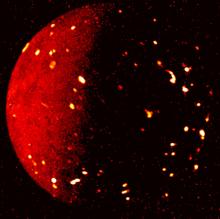Storms ripple through the atmosphere of Jupiter in this 2020 image from Hubble Space Telescope. The Great Red Spot, which is wider than Earth, is below center, with another giant oval storm just below it. Bands of clouds flow in opposite directions, with jet streams blowing at hundreds of miles per hour. The icy moon Europa stands to the left of the planet. Jupiter will appear near the Moon in the early morning hours of July 18 and 19. The solar system's largest planet looks like a brilliant star. [NASA/ESA/STScI]
You are here
Moon and Jupiter
The more we know about Jupiter, the less we know — at least about its birth. There are competing ideas about where it was born, which require different models of how it was born.
Jupiter is about two and a half times as massive as all the other planets combined. To reach that mass, the planet had to take shape far from the Sun, where conditions were nice and cold.
But just how far remains unclear. Some models say it was born at about two-thirds of its current distance from the Sun. It then moved closer to the Sun before sliding out to its present spot.
In the last few years, though, other models have emerged. In these, Jupiter was born at many times its current distance from the Sun — far beyond Pluto. That range would account for high amounts of nitrogen and other compounds in Jupiter’s atmosphere. They need extremely cold temperatures to form solid grains, which would be easier for the newly forming planet to incorporate. Those frigid conditions would have existed only far out from the Sun.
But the ideas of how it took shape there are still taking shape themselves. So there’s no agreement at all on how and where the giant planet was born.
You can ponder those questions as you look at Jupiter after midnight the next couple of nights. The planet looks like a brilliant star. It’s to the upper left of the Moon at dawn tomorrow, and closer to the upper right of the Moon on Tuesday.
Tomorrow: young stars and raspberry rum.
Script by Damond Benningfield
Today's program was made possible by Mercer Caverns, in Calaveras County in California's historic Gold Country.
Get Premium Audio
Listen to today's episode of StarDate on the web the same day it airs in high-quality streaming audio without any extra ads or announcements. Choose a $8 one-month pass, or listen every day for a year for just $30.







